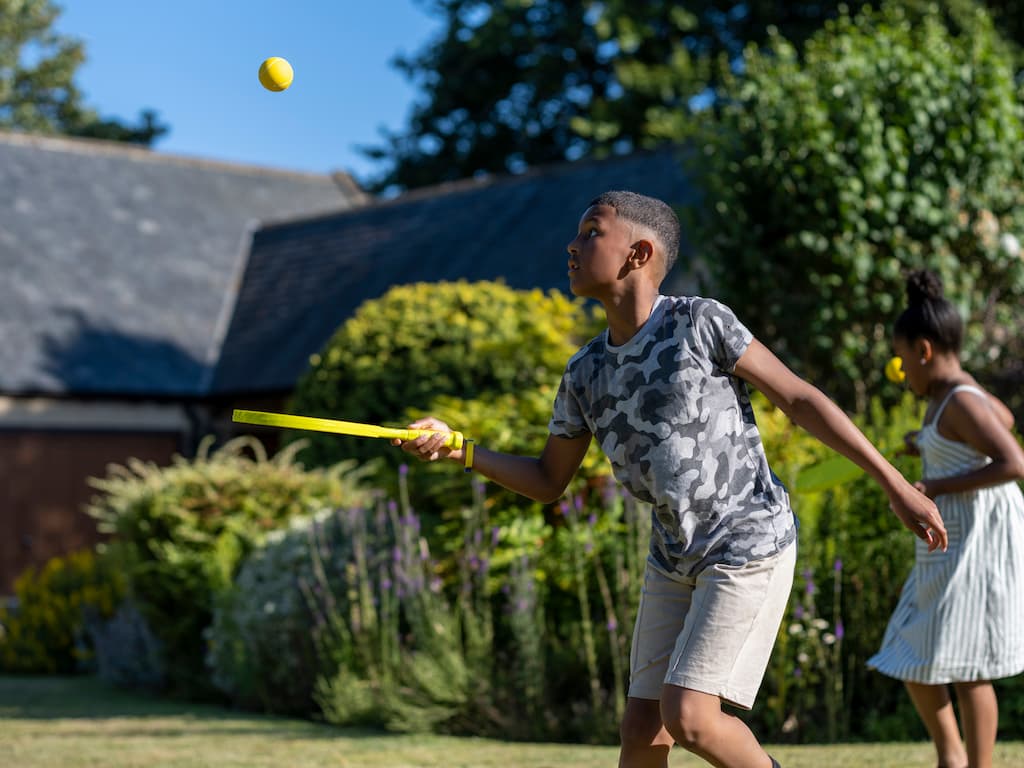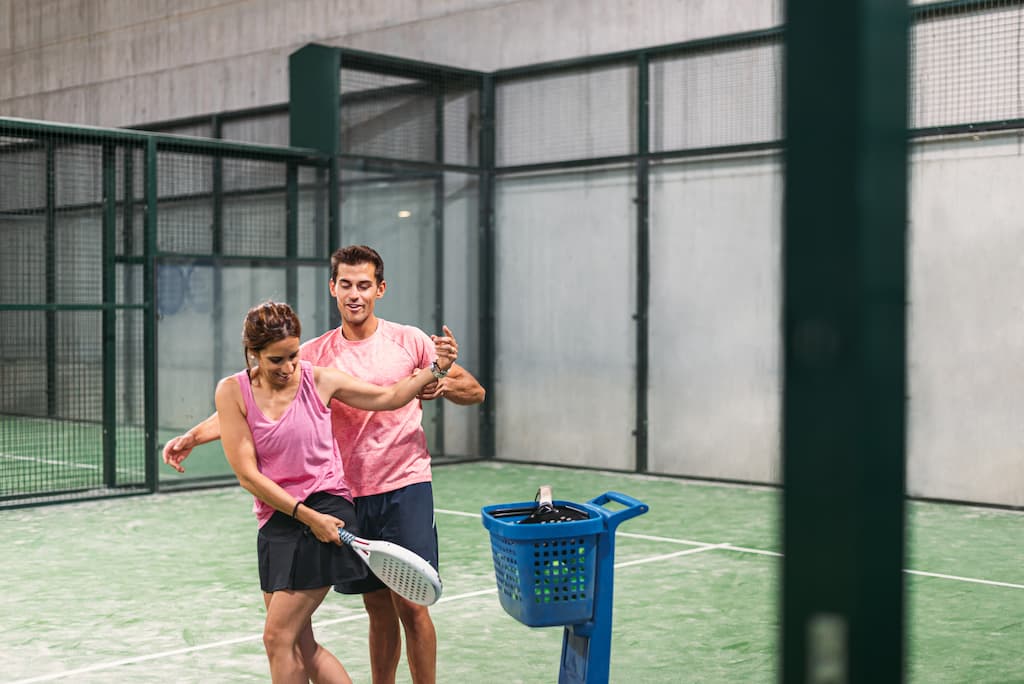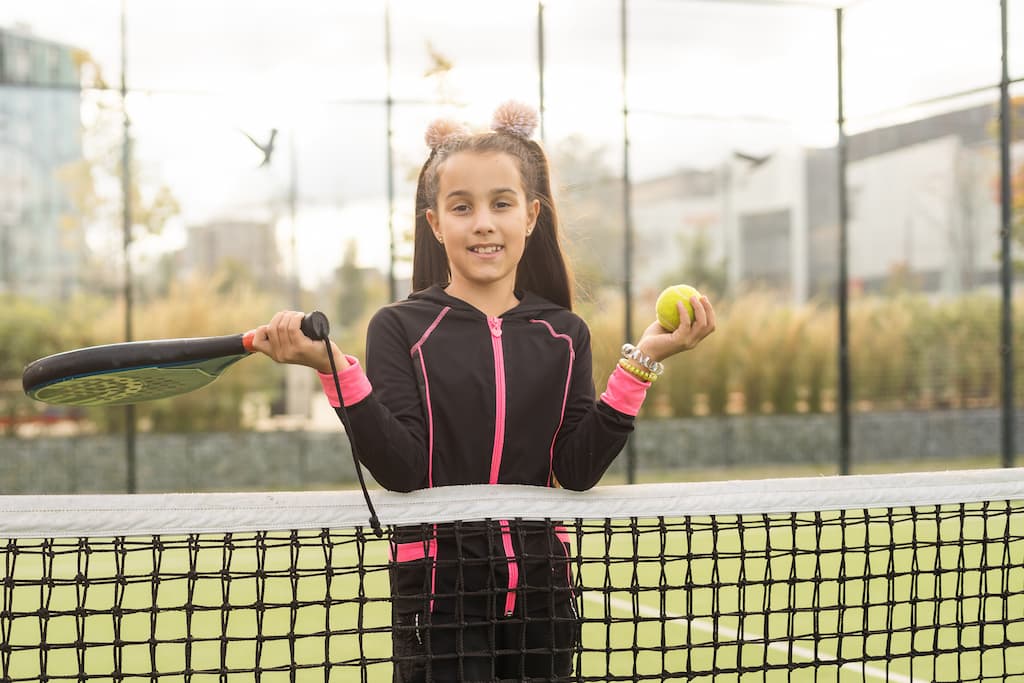Padel is quickly becoming a popular sport among young players. This fast-paced game, which is similar to tennis, is played on a smaller court and with a solid paddle instead of a racquet. Padel is easy to learn, fun to play, and provides numerous benefits for kids.
One of the biggest benefits of Padel for kids is that it promotes physical activity. The game requires players to run, jump, and use their entire body to hit the ball. This can help children develop their motor skills, coordination, and balance. Additionally, Padel is a great way to get kids outside and away from screens, which is important for their overall health and well-being.
Another benefit of Padel for kids is that it promotes socialization and teamwork. The game is typically played in pairs, which means that kids need to communicate and work together to win. This can help children develop their social skills, such as communication, cooperation, and sportsmanship. Overall, Padel is a great sport for kids of all ages and skill levels.
Key Takeaways
- Padel is a fast-paced sport that is becoming popular among young players.
- Padel promotes physical activity, socialization, and teamwork in kids.
- Padel is a great sport for kids of all ages and skill levels.
Understanding Padel
Padel is a sport that is gaining popularity among kids. It is a racquet sport that is similar to tennis and squash. It is played in doubles and is usually played on an enclosed court that is about a third of the size of a tennis court. The game is played with a solid paddle and a ball that is similar to a tennis ball but slightly smaller.
Padel was invented in Mexico in the 1960s by Enrique Corcuera, and it quickly became popular in Spain. Today, it is played all over the world and is regulated by the International Padel Federation. The Padel Pro Tour and the World Padel Tour are two of the most important professional circuits.
The rules of Padel are similar to those of tennis, but there are some key differences. For example, the ball can be played off the walls, which makes for longer rallies. This also means that players need to be able to control the ball off the walls as well as on the ground. The scoring system is also different, and games are played to the best of three sets.
Padel is a great sport for kids because it is easy to learn and can be played at any age. It is also a very social sport, as it is usually played in doubles. Kids can learn important skills such as teamwork, communication, and strategy while having fun.
In Europe and Argentina, Padel is very popular and is played by people of all ages. The sport is also gaining popularity in other parts of the world, and there are now Padel courts in places like Acapulco and other locations around the world.
Why Padel for Kids – The Benefits

Padel is an excellent sport for kids, offering numerous physical, mental, and social advantages. Here are some of the benefits of Padel for kids:
Physical Fitness
Padel is a great way for kids to stay physically active and healthy. It involves running, jumping, and hitting the ball, exercise which helps to develop cardiovascular endurance, strength, and agility. Playing Padel regularly can also improve balance, flexibility, and coordination.
Hand-eye Coordination
Padel requires excellent hand-eye coordination, which is an essential skill for many other sports and activities. Kids and adults who play Padel will develop better hand-eye coordination, which can help them in other areas of life, such as playing musical instruments or driving.
Teamwork
Padel is a team sport that requires players to work together to win. Kids who play Padel will learn how to communicate effectively, support their teammates, and work towards a common goal. These skills are transferable to other areas of life, such as school projects or group activities.
Social Interaction
Playing Padel provides an opportunity for kids to interact with others and make new friends. It can also help shy or introverted kids to come out of their shell and develop social skills. Padel is a fun and enjoyable way to meet new people and build lasting relationships.
Sportsmanship
Padel teaches kids about sportsmanship and fair play. They will learn to respect their opponents, follow the rules, and accept defeat gracefully. These values are important in all areas of life, not just sports.
Resilience
Padel can be a challenging sport, and kids who play it will learn to be resilient. They will learn to bounce back from setbacks, stay focused, and keep trying even when things get tough. These skills are valuable in all areas of life, from school to work to personal relationships.
Responsibility
Playing Padel requires kids to take responsibility for their actions. They must show up on time, follow the rules, and take care of their equipment. These habits can translate into other areas of life, such as school and home chores.
Overall, Padel is an excellent sport for kids, offering many physical, mental, and social benefits. It is enjoyable, educational, and can help kids develop valuable life skills.
Choosing the Right Equipment
When it comes to playing Padel, choosing the right equipment is crucial for kids. The right equipment can help improve their game, prevent injuries, and make the whole experience more enjoyable. Here are some factors to consider when selecting equipment for kids:
Racket
The Padel racket is the most important piece of equipment for a player. When choosing a racket for kids, consider the following:
- Material: Composite materials are the most popular choice for Padel rackets. They are durable and offer good control and power.
- Shape: Round-shaped rackets are recommended for beginners as they offer a larger sweet spot.
- Weight: Lighter rackets are easier to handle and maneuver, making them a good choice for kids.
- Comfortable: Look for a racket with a comfortable grip and a vibration dampening system to reduce the impact on the arm.
- Stability: A stable racket will help kids hit the ball with more accuracy and consistency.
Balls
Padel balls are specifically designed for the sport and come in different types. When selecting balls for kids, consider the following:
- Type: Low compression balls are recommended for kids as they are slower and easier to handle.
- Durability: Look for balls that are durable and can withstand regular use.
- Quantity: It’s always a good idea to have extra balls on hand in case some get lost or damaged during play.
Attire
Proper attire is important for safety and comfort during play. Here are some tips for selecting appropriate attire for kids:
- Padel shoes: Look for shoes with a non-marking sole and good grip to prevent slipping on the court.
- Clothing: Comfortable and breathable clothing is recommended. Avoid loose clothing that may interfere with movement.
Where to Acquire Suitable Equipment
There are many sporting goods stores and online retailers that offer Padel equipment for kids. It’s important to do some research and read reviews before making a purchase. Some stores also offer rental options, which can be a good choice for kids who are just starting out and may not be ready to commit to buying their own equipment.
Role of Parents and Coaches

Parents and coaches play a crucial role in introducing kids to the sport of Padel. Parents can support their children’s interest and progress in the sport by providing them with the necessary resources such as equipment, transportation, and financial support. They can also encourage their children to attend training sessions regularly and provide feedback on their own physical ability and progress.
Coaches have a responsibility to guide young players and foster a positive learning environment. They should provide clear instructions, demonstrate techniques, and offer constructive feedback. Coaches should also be approachable and supportive, creating a safe and welcoming environment for kids to learn and develop their skills new skill themselves.
Both parents and coaches should work together to ensure that the kids have access to a well-equipped and safe club where they can practice and play. They should also encourage their children to participate in tournaments and other competitive events, as this can help them develop their skills and confidence.
In summary, parents and coaches can have a significant impact on a child’s own development, interest and progress in Padel. By providing support, feedback, and resources, they can help young players develop their skills and foster a love for the sport.
Understanding the Scoring System
Padel uses a unique scoring system that can seem complicated at first, but with a little bit of practice, kids can easily understand and enjoy the game. The scoring system is similar to tennis, but with a few key differences.
In Padel, matches are typically played as best-of-three sets, with each set consisting of six games. The first player or team to win six games wins the set, but they must also win by a margin of two games. If the score is tied at 6-6, a tiebreaker is played to determine the winner of the set.
Scoring in Padel is done using a points system that is similar to tennis. Each game starts with a score of 0-0, which is referred to as “love.” The first point won by a player or team is worth 15 points, the second point is worth 30 points, and the third point is worth 40 points. If both players or teams are tied at 40-40, it is referred to as “deuce,” and the next player or team to win a point gets an “advantage.” If the player or team with the advantage wins the next point, they win the game. If they lose the next point, the score goes back to deuce, and play continues until someone wins by two points.
To help kids understand the scoring system, parents and coaches can provide examples and scenarios that illustrate how it works. For example, they can explain that winning a game is like earning a point in a video game, and winning a set is like beating a level. They can also use visual aids like scorecards or diagrams to help kids keep track of the score and understand the different scoring scenarios.
In summary, the scoring system in Padel is similar to tennis, but with a few key differences that kids can easily learn and begin to understand with practice and guidance from parents and coaches. By breaking down the scoring system into simple steps and providing examples and scenarios, kids can enjoy playing Padel and develop their skills in the sport.
Safety for Kids Playing Padel
When it comes to kids playing Padel, safety is a top priority. Whether they are just starting out or have been playing for a while, it is important to take all necessary precautions to ensure that they have a safe and enjoyable experience on and off the court.
Protective Gear
One of the most important safety considerations for kids playing Padel is wearing the right protective gear. This includes:
- Padel shoes with good grip and support to prevent slips and falls
- Eye protection to prevent injuries from flying balls or rackets
- Elbow and knee pads to protect against scrapes and bruises
- A helmet for younger or less experienced players
Court Safety
It is also important to ensure that the court is safe for kids to play on. This includes:
- Regularly checking the court surface for cracks or other damage
- Keeping the court free of debris or obstacles that could cause tripping or other accidents
- Ensuring that the court is well-lit and visible, especially during evening or night games
Supervision
Another important safety consideration for kids playing Padel is supervision. Younger or less experienced players should always be supervised by an adult or coach who can help them learn the game safely and prevent accidents.
Guidelines and Recommendations
To ensure a safe and enjoyable Padel experience for kids, it is important to follow these guidelines and recommendations:
- Choose Padel products from reputable brands that are known for their quality and safety, such as Siux Electra ST2 Junior, Wilson Blade Junior V2, and RS Padel Cobra Edition Junior.
- Look for products that are flexible, resistant, and offer exceptional power, such as Asics Gel-Resolution 9 GS Clay White Lime Junior, Asics Gel-Resolution 9 GS Clay Turquoise Blue Junior, and Head Delta Junior 2022.
- Consider products that offer great comfort and durability, such as KSwiss Hypercourt Express 2 HB White Blue Girl and KSwiss Hypercourt Express 2 HB Blue Kid.
- For players looking for high performance, consider products such as Bullpadel Vertex 23 Niña and Adidas Ubersonic 4 K Black Junior.
By following these guidelines and recommendations, parents and coaches can help ensure that kids have a safe and enjoyable experience playing Padel.
Padel Drills for Kids
When it comes to teaching kids how to play Padel, drills can be an effective way to develop their skills, build teamwork, and make the learning process fun. Here are some more Padel lessons and drills that are tailored specifically for kids:
- The Wall Game: This drill is great for developing accuracy and control. The objective is to hit the ball against the wall and keep it going for as long as possible. Kids can work on their forehand and backhand shots, and the drill can be made more challenging by adding a time limit or increasing the distance from the wall.
- The Partner Game: This drill focuses on teamwork and communication. Kids are paired up and take turns hitting the ball to each other, trying to keep it going as long as possible. The objective is to work together to keep the ball in play and develop a sense of trust with their partner.
- The Cone Game: This drill is great for developing footwork and agility. Cones are set up on the court, and kids have to move around them while hitting the ball to their partner. The objective is to work on their footwork and coordination while keeping the ball in play.
- The Serve and Return Game: This drill focuses on serving and returning. Kids take turns serving the ball and then returning their partner’s serve. The objective is to work on their serving technique and develop their ability to return different types of serves.
- The Target Game: This drill is great for developing accuracy and control. Targets are set up on the court, and kids have to hit the ball to specific areas. The objective is to work on their aim and develop their ability to hit the ball to different parts of the court.
Frequently Asked Questions
What age is appropriate for kids to start playing Padel?
Kids can start playing Padel as early age as 5 or 6 years old. However, it is important to keep in mind that children develop at different rates and have varying levels of coordination and motor skills. Parents should assess their child’s physical abilities and comfort level before introducing them to the sport.
What are some tips for teaching kids how to play Padel?
When teaching kids how to play Padel, it is important to keep the experience fun and engaging. Here are some tips:
• Start with the basics: Teach kids the basic rules and techniques of Padel, such as how to hold the racket, how to hit the ball, and how to move on the court.
• Use appropriate equipment: Make sure kids are using age-appropriate rackets and balls to ensure they can play comfortably and safely.
• Emphasize teamwork: Padel is a doubles sport, so teach kids how to work together with their partner to win points.
• Encourage sportsmanship: Teach kids to respect their opponents and play fair, win or lose.
Is indoor Padel a good option for kids?
Indoor Padel can be a great option for kids, especially during the colder months or in areas with inclement weather. Indoor courts provide a controlled environment where kids can safely practice and play. Additionally, indoor Padel courts are often smaller than outdoor courts, making them more manageable for young players.

